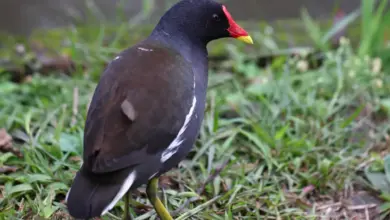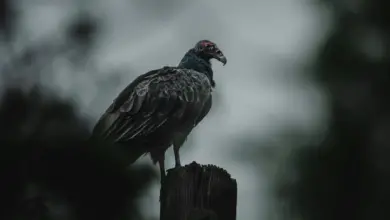The Chestnut-mandibled Toucans or Swainson€™s Toucans (Ramphastos swainsonii) are the second largest Toucans in the world – being only slightly smaller than the Toco Toucans (Ramphastos toco). Their most obvious feature is their massive bill.
[ez-toc]
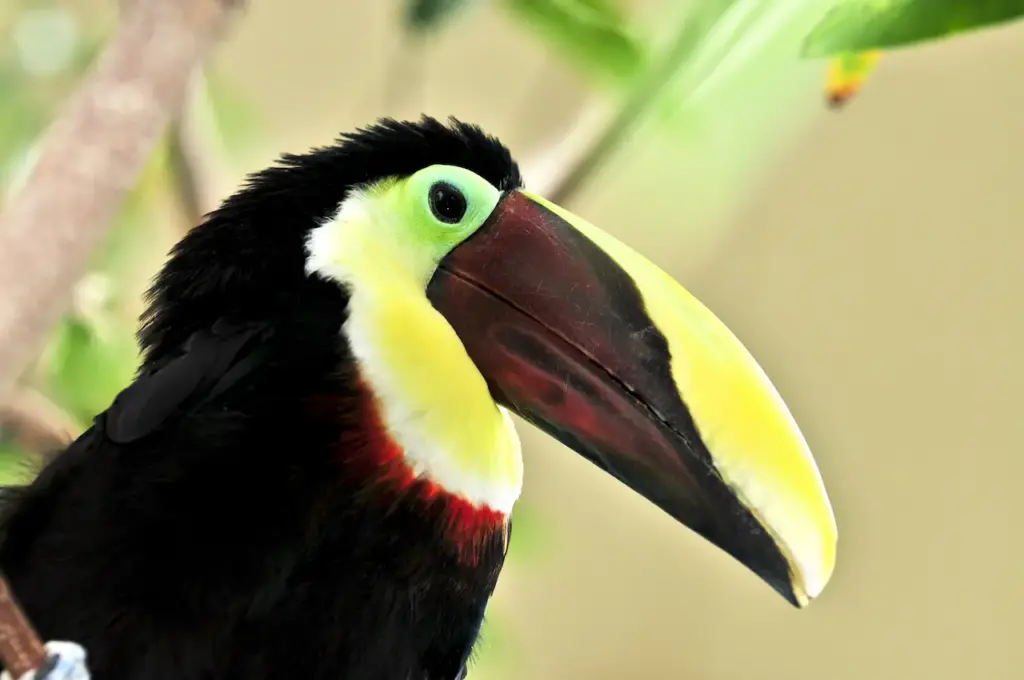
This Latin American species is replaced from southern Colombia to eastern Peru by the similar and closely related Black-mandibled Toucan (Ramphastos ambiguus), with which it is considered conspecific (of, or belonging to, the same species). These two species can readily be differentiated by their different sizes and bill pattern / coloration. Another toucan species found within their range is the Keel-billed Toucan; however, even though the plumage coloration is also quite similar, the latter can easily be identified by the smaller size and – above all – distinctive, multi-colored bill.
Their natural range stretches from Central America to the Northwestern coast of South America.
In the United States, these toucans are very popular in aviculture and as pets; and they are the most readily-available large toucan species. They are, however, quite noisy compared to other toucans and require an elaborate set-up to accommodate them.
Chestnut-mandibled Toucans Distribution / Habitat
The Chestnut-mandibled Toucans occur naturally from southeastern Honduras south Nicaragua and Costa Rica through northwestern Colombia (east to the Cauca Valley) and along the Andes south and east to Venezuela and west to the El Oro province in southwestern Ecuador. They are fairly common throughout most of their range and are resident (non-migratory).
They inhabit tropical lowland rainforests, but can also occupy gallery forests, plantations, parks or gardens with trees suitable for nesting, roosting and feeding. They tends to occupy the canopies of forests, but are also commonly seen flying among the clearings or semi-open areas among the trees.
These birds are typically seen in pairs (particularly when breeding); and outside the breeding season in small family groups or flocks of 3 to 12 birds. They often follow Keel-billed Toucans to take advantages of their food sources.
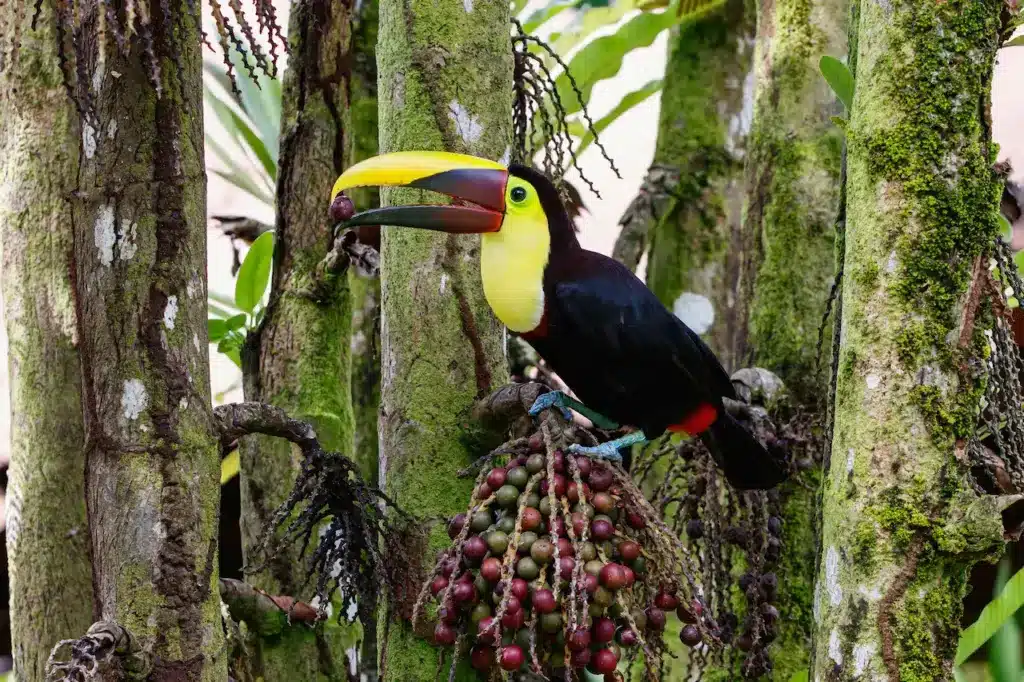
Chestnut-mandibled Toucans Description
The large Chestnut-mandibled Toucans have massive, brightly marked bills that can grow up to 7.8 inches (~ 20 cm) long.
Males and females are identical, except for a small size difference. Males measure from 21.7 – 23.6 inches (55 – 60 cm) in length – including the tail, and weigh about 26.5 oz (750 g). The smaller females are 19.7 – 20.9 inches (50 – 53 cm) long, and weigh about 20.5 oz (580 grams).
The plumage is mainly black with hints of maroon on the head, upper back and lower chest. The face, throat and upper chest are bright yellow, and form the shape of a bib. This “bib” is bordered by a narrow white line followed by a broader red band. The rump is white and the lower abdomen and lower tail feathers (vent) are red.
The bicolored bill is mostly bright yellow above; the base of the bill is dark red turning into dark maroon color and blackish towards the tip of the lower bill.
The eyes (irises) are olive and the bare skin around the eyes is yellowish-green.
The legs and feet are bright blue.
Juveniles
The immature bird has a sooty black plumage, a duller bib, and a paler vent feathers than the adult’s.
Similar Species
They resemble the smaller Keel-billed Toucans and the larger Toco Toucans, but these toucans can easily be differentiated by their varying bill patterns and body sizes.
Chestnut-mandibled Toucans Breeding
Breeding mostly occurs from early April to early June.
Chestnut-billed Toucans usually make their nests in unlined cavities high in decayed sections of dead or living trees, or occasionally in old woodpecker nests. Since their bills are not suitable for excavating holes, they have to rely on existing cavities.
The 2-4 glossy white eggs are laid on a few wood chips created while enlarging the opening and on various kinds of regurgitated seeds collected for this purpose.
Parents share equally in the incubation of the eggs, but rarely sit on the nest for more than an hour at a time and the eggs are often left uncovered. The incubation period is about 17 – 19 days to hatching.
The nestlings are born blind, with no trace of down on their pink skin. The chicks have pads on their elbows that protect and keep them elevated from the rough and damp floor. The bill is unremarkable until about 16 days old when it takes on the distinguishing features of the toucan, and requires up to four months to develop fully. Feathers begin to expand at 4 weeks. They young fledge when they are about 5 – 6 weeks old. Both parents share in feeding fruit to the babies for up to 9 weeks, at which time they are usually self-feeding.
Breeding in captivity requires attention to a number of details. Even successful breeders report rates as low as 30% for the incubation of eggs.
Toucan Trivia: Unexpected, Interesting and Fun Facts about the Toucan Family of Birds
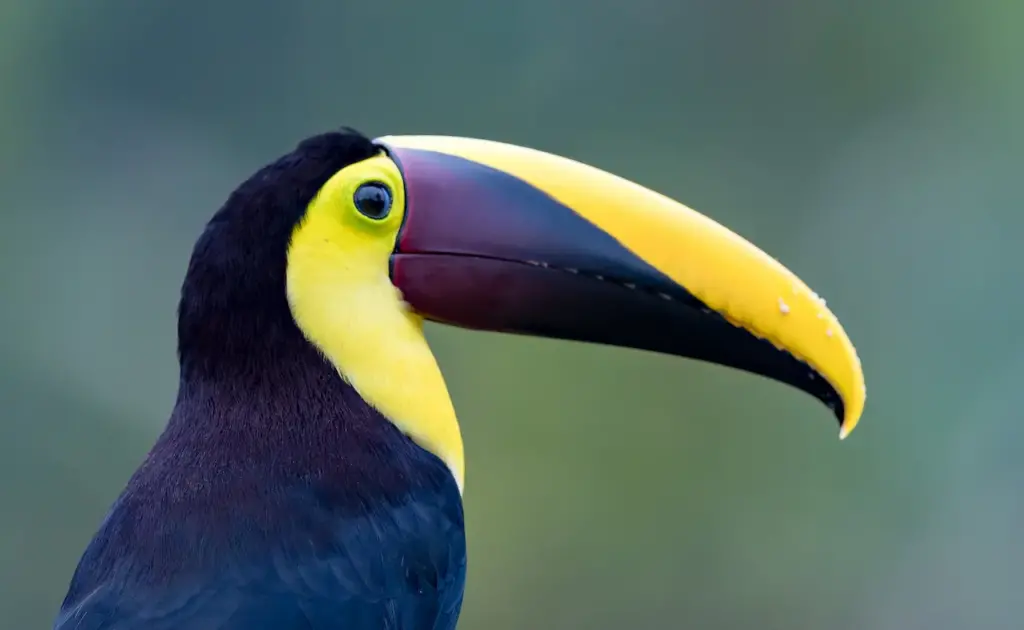
Chestnut-mandibled Toucans Calls / Vocalizations
The various calls of the Chestnut-mandibled Toucans are described as yelping “yo-YIP, a-yip, a-yip,” “keeuREEK kirick, kirick“, or “keeyos taday taday” – which is described by locals as being “Dios te dé, Dios te dé“, which is Spanish for “God keep you”. Their calls are often heard as they fly through the trees, but are also vocalized in choruses at the evening roosts. They also give off loud, rapid piglike rattles that are reminiscent to the flapping pages of a heavy book.
Sound Recordings
Alternate (Global) Names
Chinese: ????? … Czech: Tukan hnedohrbetý, tukan hn?doh?betý … Danish: Brunnæbbet Tukan … Dutch: Swainsons Toekan, Swainson-toekan … Finnish: Ruskonokkatukaani … French: Toucan de Swainson … German: Swainson Tukan, Swainsontukan … Italian: Tucano beccocastano, Tucano di Swainson … Japanese: nishokukimuneoohashi … Norwegian: Gulnebbtukan … Polish: tukan brazowodzioby, tukan br?zowodzioby … Russian: ???????????????? ????? … Slovak: tukan hnedozobý … Spanish: Tucán de Pico Castaño, Tucan de swainson, Tucán de Swainson, Tucán mandÃbula negra, Tucán Pechiamarillo Norteño, Tucán pico café … Swedish: Rostnäbbad tukan

